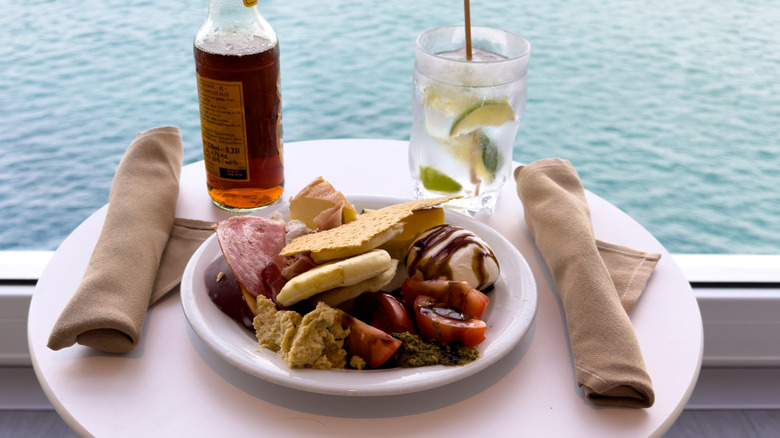Why You Should Think Twice Before Eating Soft Cheeses On A Cruise
Tuck that piña colada-brella behind your ear and grab a fresh plate because a cruise ship buffet isn't gonna eat itself. Thanks to options like Belgian waffle stations, made-to-order Neapolitan pizzas, never-ending Kaito sushi trains, and dreamy chocolate melting cakes, you won't return to the towel-in-your-room-that's-shaped-like-a-swan hungry. But as you DIY your charcuterie board with the crème de la self-serve, you might want to pass right on by the soft cheese. If it hasn't been properly stored, there's a chance it could make you sick.
Along with toppling cabanas on a windy deck, and your cabin neighbor arriving with a guitar and an amp, fluctuating food temperature is a definite red flag on a cruise. While you can monitor the hours you spend baking yourself in the sun by the pool, the length of time the cheese display has languished on disappearing ice is a mystery. Softer cheese with its velvety-rich moisture content (like goat, brie, blue, Camembert, and gorgonzola) is more susceptible to listeria contamination than harder cheese (like parm, Comté, manchego, and aged cheddar) — never mind those touchpoint terrorizing tong-tuh-tong-tong-tongs. The cheese rule also goes for creamy, dairy desserts like cheesecake or custard that you might find sitting around at room temperature. If you'd like to indulge in a cheese course, or a slice of Funfetti Cheesecake, order it in the main dining room where food-safe temperature and storage has been consistently monitored by staff.
While unknown sources have contributed to headline-making listeria outbreaks on cruise ships in the past, knowing which soft cheeses to save for dry land will keep you safe from a seven-day adventure on the seas with gastroenteritis.
Other cruise ship foods you can throw overboard
Listen, you're basically eating your way through a floating buffet that's a few too many nautical miles off shore to be freshly stocked. So, unless you've been fishing off the starboard side — and catching enough crab for everybody — it's a good idea to make a mental note of the other foods you should probably skip on your cruise.
It's all hands on deck when it comes to the buffet — especially the frequently-handled cranks, buttons, and cones at the kid-friendly soft serve station. But soft serve also requires an extremely specific temperature to stay smooth and safe (between 24 and 37 degrees Fahrenheit), which can be tough to maintain. If you feel like something sweet, grab a sundae from a server in the dining room, or a specialty shop.
Sushi and sashimi are other vacay favorites that are better enjoyed off the boat. While cruise lines build their reputations on flawless experiences, there's always room for error when it comes to raw fish. Those show-stopping rainbow rolls, enjoying the sultry evening breeze on the buffet? They may be teetering above food-safe temps, vulnerable to bacteria like Clostridium perfringens which loves a warm, raw protein. Instead, go for that incredible swordfish that's fully cooked and comes with a side of Instagram likes.
A good rule of thumb for cruise ship dining is: Cooked food should be hot, cold food should be cold, and if you aren't sure, it's better to be safe than sorry. Beyond that, it's up to you whether you get up the guts to finally try the surf simulator in front of 6,000 strangers.

